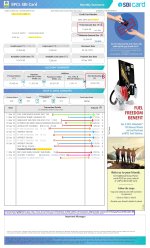Introduction
Brands like Apple, Samsung, etc offer lucrative cashbacks (on EMI transactions) where they have a sharing arrangement with the credit card issuer. Therefore, in order to avail the cashback, customers are forced to enter into EMI contracts as the brands do not offer cashback on normal transactions. Foreclosure of the EMI contract attracts penal charges of approximately 3% thus diluting the whole deal.Why EMI and not the regular transactions?
Well, below is what I think –- Brands get to sell their products and generate brand awareness owing to those offers.
- Banks too get an opportunity to generate awareness about their credit cards owing to those offers.
- Bank get a certain return on investment in the form of interest as the customer is buying on EMI.
- Banks get to retain the customer for a certain period as he will not want to foreclose the EMI contract which will attract penal charges in most cases.
- Such transactions are with select Banks only. This attracts new customers who want to avail cashbacks and helps to generate new business for the bank.
- Banks and Brands enjoy free mouth publicity by store sales people who have no choice but to ask the customers if they have the credit card of that particular bank.
- Customers require less or no money to pay upfront, thus Brands get an opportunity to upsell a more premium variant of their product (say if one is going to buy a mobile worth 20k, then the credit card holder can be easily convinced to buy a 30k variant).
How it works for the Credit Card Holder
EMI transactions are split into 2 parts - Principle and Interest. Charges for the customer generally fall in to the following descriptions -Interest - The Bank mentions the rate of interest which will be charged in the chargeslip (say 14% to 15%) but it is on the reducing balance method. However, since the contract generally goes for 3 to 6 months, the amount comes to approximately 3% of the the total transaction value. Part or whole of the interest cost is generally given back to the customer by the Brand in the form of Merchant Cashback.
EMI conversion fee – The Banks generally charge an EMI conversion fee which ranges from 99 to 199 plus 18% Gst. Axis Bank and some others charge 1% of the transaction amount as EMI conversion fee.
GST on Interest - GST is applicable on the interest portion of the transaction which adds another 0.5% to the cost.
Other than that, banks put a hold on the credit limit of the card which is equal to the principle amount of EMI and do not allow the customer to use that amount. This hold is released with each EMI and is finally lifted away after all EMI amounts are paid back by the customer.
How to read a credit card statement (or bill) –
The primary reason for a credit card statement is for the customer to understand how he spent his money. What the bank has put up as charges and a collective summary of accrual and redemption of reward points. Other stuff such as statement date, payment due date, total amount due and minimum amount due are self-explanatory but form an integral part of the statement.A credit card statement would normally display the following –
Opening balance due - (normally indicated by a Debit balance)
Add - purchases and charges (all debit transactions)
Less - deposits, refunds and cashbacks (all credit transactions)
Closing balance - (debit or credit after adjusting the above)
How SBI displays EMIs in its credit card statements –
In line with accounting principles and in order to keeps their account books in sync with the actual income received, banks debit the interest amount on accrual basis (as and when it is due). For EMI transactions too, banks follow the same practice of collecting interest and gst charges (on the interest amount) on accrual basis.In the SBI credit card statement, the Previous Balance shown in the statement includes the outstanding principle. Since the principle part of the EMI is not a charge that the bank is levying, therefore it is not shown under Purchases. However, the Principle amount of the EMI is added to the statement total due amount. Therefore, we will find that Total Amount Due in the statement is different from Total Outstanding, since total outstanding also includes the principle component of the Entire Loan Amount.
SBI posts MEMO entries for charged EMIs which are colored in gray and it is clearly mentioned that such entries do not constitute part of Purchases and Other Debits (marked in a blue box in in the current month statement image).
How to arrive at the Total Amount Due –
If one goes according the statement and adjusts all the debits and credits, he will get the Total Outstanding (labelled B in current bill image). Well, to arrive at the Total Amount Due for the current statement, do the following -- Take the Last Amount Due from previous month’s statement
- Add all Purchases, debits and fees (excluding Interest charged by the bank on EMI)
- Less all payments and cashbacks received (excluding Interest cashback received by manufacturer against EMI)
- Add all EMI Amounts which are payable.
- The amount at which you arrive will be the Total Amount Due.
| Action | Particulars | Labels | Amounts | Totals |
| Opening Balance | Amount due from previous statement | A (Maroon Box) | | 9808.00 |
| Add | Purchases, Charges and Fees | E,F,G,H (Red Arrows) | 99+499+220.80 +202.36 | 1021.16 |
| Less | Payments and Cashbacks | C,D (Green Arrows) | 2+9808 | 9810.00 |
| Add | EMI Amounts Due | M,O,P (Brown Arrows) | 4883.62+4883.62 +4877.97 | 14645.21 |
| Ignore | Ignore - Interest on EMI | J,K,L (Blue Arrows) | 56.31+56.31 +515.99 | 628.21 |
| Ignore | Ignore - Cashback from Manufacturer | I (Blue Arrow) | 1719.96 | 1719.96 |
| Closing Balance | Total amount due of Current Statement | S (Red Box) | | 15664.37 |
What your your thoughts?
What do you think? Feel free to comment and add something or rant. Hit a Like, if you enjoyed this.Thanks!!
Ravi.
Attachments
Last edited:







